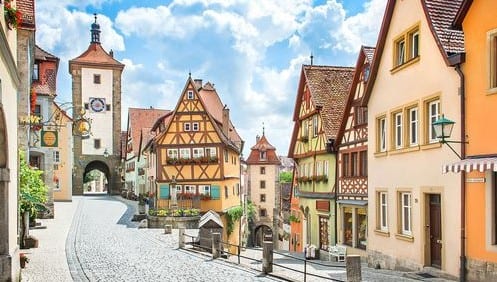
Located in central Europe, Germany is made up of the North German Plain, the Central German Uplands (Mittelgebirge), and the Southern German Highlands. The Bavarian plateau in the southwest averages 1,600 ft (488 m) above sea level, but it reaches 9,721 ft (2,962 m) in the Zugspitze Mountains, the highest point in the country. Germany’s major rivers are the Danube, the Elbe, the Oder, the Weser, and the Rhine. Germany is about the size of Montana.
History
The Celts are believed to have been the first inhabitants of Germany. They were followed by German tribes at the end of the 2nd century B.C. German invasions destroyed the declining Roman Empire in the 4th and 5th centuriesA.D. One of the tribes, the Franks, attained supremacy in western Europe under Charlemagne, who was crowned Holy Roman Emperor in 800. By the Treaty of Verdun (843), Charlemagne’s lands east of the Rhine were ceded to the German Prince Louis. Additional territory acquired by the Treaty of Mersen (870) gave Germany approximately the area it maintained throughout the Middle Ages. For several centuries after Otto the Great was crowned king in 936, German rulers were also usually heads of the Holy Roman Empire.
By the 14th century, the Holy Roman Empire was little more than a loose federation of the German princes who elected the Holy Roman Emperor. In 1438, Albert of Hapsburg became emperor, and for the next several centuries the Hapsburg line ruled the Holy Roman Empire until its decline in 1806. Relations between state and church were changed by the Reformation, which began with Martin Luther’s 95 theses, and came to a head in 1547, when Charles V scattered the forces of the Protestant League at Mühlberg. The Counter-Reformation followed. A dispute over the succession to the Bohemian throne brought on the Thirty Years’ War (1618–1648), which devastated Germany and left the empire divided into hundreds of small principalities virtually independent of the emperor.
Education
The educational system of Germany is underlying to continuous changes and reforms. Main point in the last years was the reorganization of the Gymnasium. The nine year education was changed into an eight year education to get the Abitur. Furthermore, the academic system had changed because of the Bologna reform. The degrees obtained are now called Bachelor and Master.
-
Top universities in North Rhine-Westphalia
 The most populous German state, North Rhine-Westphalia is located in the west of Germany and is home to approximately 17.5 million, some 22% of the nation’s population. A prime location to study in Germany, North Rhine-Westphalia claims the highest number of top German universities (nine) and is home to the city of Düsseldorf (its capital) and Cologne (its largest city). Rheinisch-Westfälische Technische HochschuleAachen is the top ranked university in North Rhine-Westphalia, at 147th in the world. It is the only TU9 member in the state and one of two institutions in the region to receive funding from the government’s Excellence Initiative. The other is Universität Köln. The top universities in North Rhine-Westphalia are:
The most populous German state, North Rhine-Westphalia is located in the west of Germany and is home to approximately 17.5 million, some 22% of the nation’s population. A prime location to study in Germany, North Rhine-Westphalia claims the highest number of top German universities (nine) and is home to the city of Düsseldorf (its capital) and Cologne (its largest city). Rheinisch-Westfälische Technische HochschuleAachen is the top ranked university in North Rhine-Westphalia, at 147th in the world. It is the only TU9 member in the state and one of two institutions in the region to receive funding from the government’s Excellence Initiative. The other is Universität Köln. The top universities in North Rhine-Westphalia are:Rheinisch-Westfälische Technische Hochschule Aachen (147th in the world; 9th in Germany)
- Rheinische Friedrich-Wilhelms-Universität Bonn (177th in the world; 11th in Germany)
- Westfälische Wilhelms-Universität Münster (249th in the world; 16= in Germany)
- Universität zu Köln (305th in the world; 23rd in Germany)
- Ruhr-Universität Bochum (388th in the world; 28th in Germany)
- Universität Düsseldorf (411-420 in the world; 32nd in Germany)
- Technische Universität Dortmund (TU Dortmund, 491-500 in the world; 36= in Germany)
- Universität Bielefeld (501-550 in the world; 38= in Germany)
- Universität Duisburg-Essen (501-550 in the world; 38= in Germany)
-
Top universities in Baden-Württemberg
 The third largest German state in terms of both population and size, Baden-Württemberg is home to 11 million people. As well as thriving automobile, engineering and metallurgical sectors, Baden-Württemberg is famous for its fairytale forests and historic towns. Baden-Württemberg is home to two TU9 members (Universität Stuttgart and Karlsruhe Institute of Technology, KIT) as well as the highest-ranked university at which to study in Germany –Ruprecht-Karls-Universität Heidelberg.
The third largest German state in terms of both population and size, Baden-Württemberg is home to 11 million people. As well as thriving automobile, engineering and metallurgical sectors, Baden-Württemberg is famous for its fairytale forests and historic towns. Baden-Württemberg is home to two TU9 members (Universität Stuttgart and Karlsruhe Institute of Technology, KIT) as well as the highest-ranked university at which to study in Germany –Ruprecht-Karls-Universität Heidelberg.The capital and largest city of Baden-Württemberg is Stuttgart. The top universities are:
- Ruprecht-Karls-Universität Heidelberg (49th in the world; 1st in Germany)
- Universität Freiburg (121st in the world; 4th in Germany)
- Karlsruhe Institute of Technology (KIT, 127th in the world; 5th in Germany)
- Eberhard Karls Universität Tübingen (141st in the world; 7th in Germany)
- Universität Ulm (249th in the world; 16= in Germany)
- Universität Stuttgart (274th in the world; 19th in Germany)
- Universität Konstanz (310th in the world; 24th in Germany)
- Universität Mannheim (328th in the world; 25th in Germany)
-
Top universities in Bavaria
 The biggest state by size and the second-largest by population, Bavaria is home to 12.5 million people. With diverse industry in technology, engineering, beer and tourism (anyone for lederhosen?), the state’s top two universities two are Ludwig-Maximilians-Universität München and Technische Universität München (TU München), which both gain funding from the government’s Excellence Initiative and one of which, TU München, is a member of TU9.
The biggest state by size and the second-largest by population, Bavaria is home to 12.5 million people. With diverse industry in technology, engineering, beer and tourism (anyone for lederhosen?), the state’s top two universities two are Ludwig-Maximilians-Universität München and Technische Universität München (TU München), which both gain funding from the government’s Excellence Initiative and one of which, TU München, is a member of TU9.Two of the top universities in Bavaria are located in München (aka Munich), the capital and largest city in the state. The top universities in Bavaria are:
- Ludwig-Maximilians-Universität München (52nd in the world; 2nd in Germany)
- Technische Universität München (TU München, 54th in the world; 3rd in Germany)
- Universität Erlangen-Nürnberg (285th in the world; 20th in Germany)
- Julius-Maximilians-Universität Würzburg (341st in the world; 26th in Germany)
- Universität Regensburg (395th in the world; 29th in Germany)
- Universität Bayreuth (481-490 in the world; 35th in Germany)
visit : Top University in German for more information
